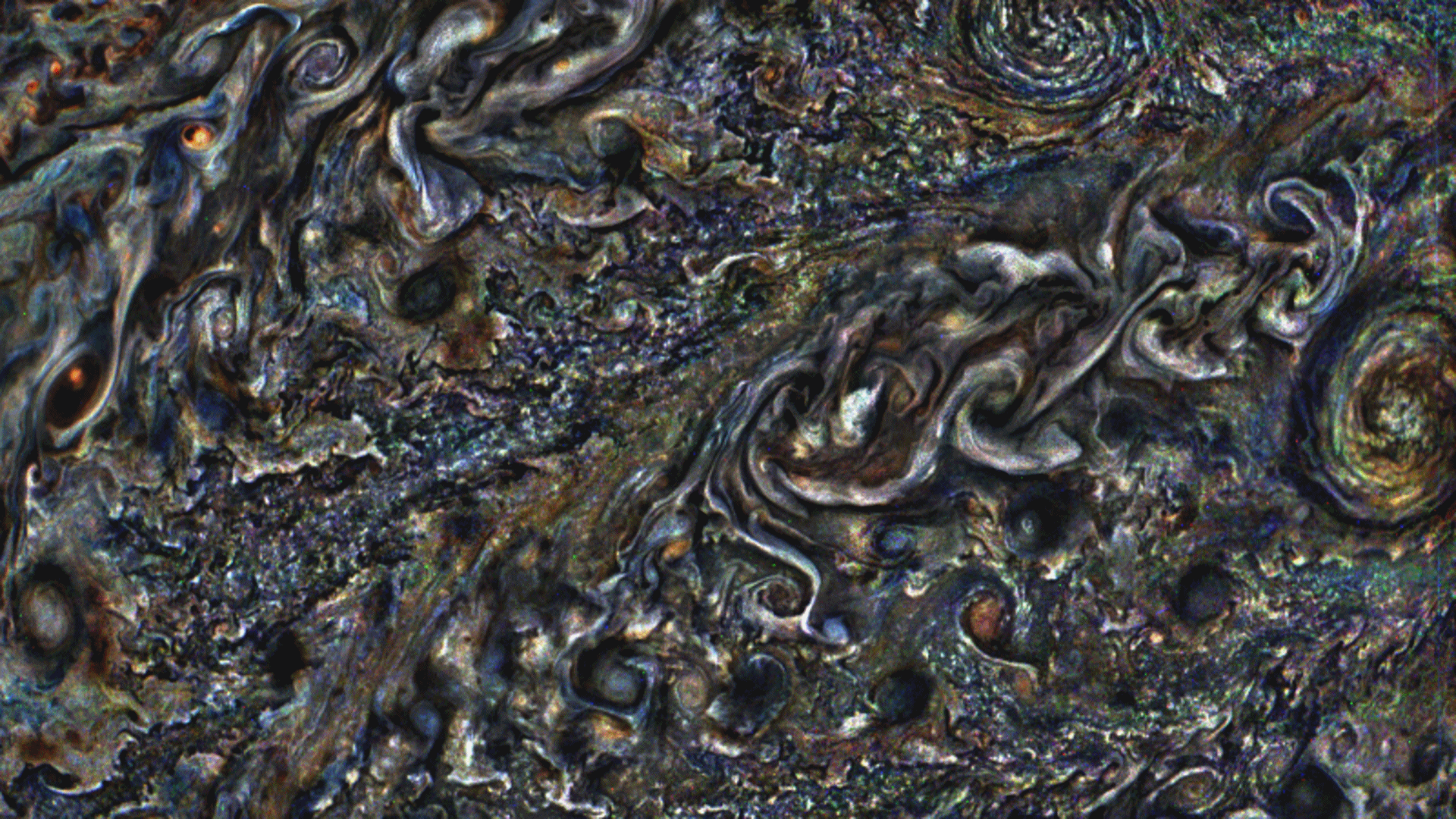Jupiter's Swirling Clouds Are Mesmerizing in These Views from Juno
Mesmerizing new views from NASA's Juno spacecraft capture a colorful mosaic of swirling clouds in Jupiter's atmosphere.
The JunoCam instrument on board Juno snapped photos of the swirling clouds above Jupiter's south pole shortly after the spacecraft made its closest approach to the gas giant on April 1. The photos were taken only 15,379 miles (24,749 kilometers) above Jupiter's cloud tops.
Citizen scientists Gerald Eichstädt and Seán Doran then compiled the images into a stunning animation, illustrating the evolution of Jupiter's swirling cloud tops. [In Photos: Juno's Amazing Views of Jupiter]

"This animation represents a 'feasibility test,'" Eichstädt, a member of the Planetary Society who works as a mathematician and processes Juno imagery in his spare time, said in a statement. "Building on this initial work, we can add in more variables that will give us a more detailed description and physical understanding of Jupiter's atmosphere."
Using the new JunoCam images, the two citizen scientists were able to model the subtle motions within the gas giant's atmosphere and extrapolate the swirling evolution of clouds. The two citizen scientists also used the new images to create a composite image that offers an enhanced view of the whole planet, according to the statement.

"The contribution of the Earth-based support campaign to the Juno mission, both professional and amateur, has proven to be invaluable in filling the spatial, temporal, and spectral gaps in Juno's capabilities," Leigh Fletcher, Royal Society research fellow from the University of Leicester, said in the statement. "Now two years into the mission, we've seen some tremendous new science emerging from this collaboration, and breath-taking imagery of Jupiter's complex atmosphere that would not have been possible without the talented army of citizen scientists that have been working alongside the JunoCam team every step of the way."
Creating the new composite images was a "labor of love," Doran said in the statement. The JunoCam uses what's called a CCD (charge-coupled device) to record incoming photons of light.
Get the Space.com Newsletter
Breaking space news, the latest updates on rocket launches, skywatching events and more!
However, "energetic particles impact the CCD and produce bright specks," Doran said. "Once I'd finished the processing, I needed to go through and repair a couple hundred of these bright pixels."
Contributions from citizen scientists aid in the detection of rapid atmospheric changes on Jupiter that might otherwise go unnoticed, Glenn Orton, Juno science team member from NASA's Jet Propulsion Laboratory in California, said in the statement.
"Thus, they not only measure changes between Juno's close encounters with Jupiter, but they also provide a means to anticipate changes that might influence how future observations can be interpreted, and they could even influence decisions on Juno's observing strategy in the case of unexpected phenomena," Orton said.
The new animation and composite images were presented at the Royal Astronomical Society in London on May 10 and May 11.
Follow Samantha Mathewson @Sam_Ashley13. Follow us @Spacedotcom, Facebook and Google+. Original article on Space.com.
Join our Space Forums to keep talking space on the latest missions, night sky and more! And if you have a news tip, correction or comment, let us know at: community@space.com.

Samantha Mathewson joined Space.com as an intern in the summer of 2016. She received a B.A. in Journalism and Environmental Science at the University of New Haven, in Connecticut. Previously, her work has been published in Nature World News. When not writing or reading about science, Samantha enjoys traveling to new places and taking photos! You can follow her on Twitter @Sam_Ashley13.









